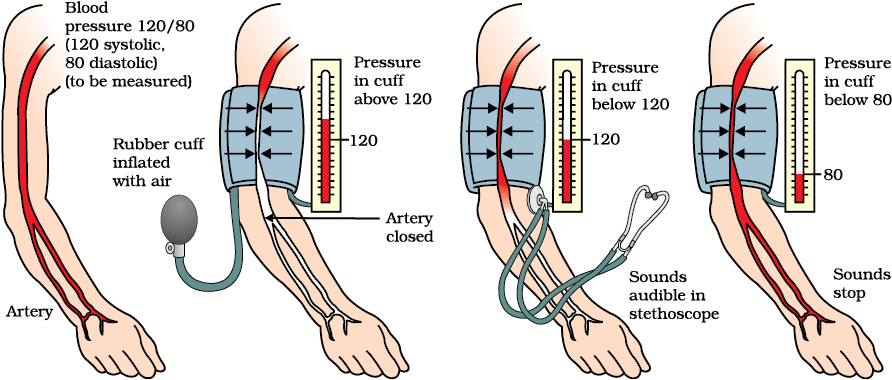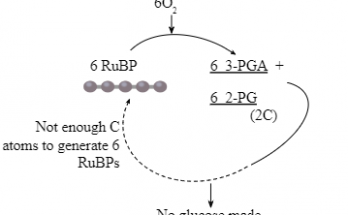Table of Contents
What Is Blood Pressure?
Blood pressure is the force exerted by circulating blood on the walls of blood vessels, especially the arteries as it flows through the body.
- The blood is an important liquid connective tissue that flows in the blood vessels and helps in transportation.
- It exerts a force against the walls of vessels.
- The blood pressure inside the arteries is much more as compared to inside the veins.
Blood Pressure can be defined as “The pressure at which the blood is pumped against the wall of a Blood vessels”
Blood Pressure is measured as two values- Systolic and Diastolic blood pressure.
- Systolic blood pressure is the pressure in the arteries when the heart beats and pumps blood out.
- Diastolic blood pressure is the pressure in the arteries when the heart is at rest between beats. Blood pressure is typically measured in millimeters of mercury (mmHg).
The normal range for blood pressure in healthy adults is generally considered to be around 120/80 mmHg. However, it can vary depending on factors such as age, sex, weight, and overall health. Blood pressure that consistently measures higher than 140/90 mmHg is considered high and can be a risk factor for various health conditions like heart disease, stroke, and kidney damage.
Blood Pressure is measured with the help of an instrument, called a Sphygmomanometer.
Types of Blood Pressure
There are two main types of blood pressure –
- Systolic Pressure
- Diastolic Pressure.
Also Check – Transportation in Human Beings Class 10
Also Check – Describe the Flow of Blood through the Heart of Human Beings
Systolic Pressure
- Systolic blood pressure measures the force of the blood pushing against the walls of the arteries when the heart beats and pumps blood out. Systolic blood pressure is the highest pressure in the arteries during a heartbeat.
- Systolic blood pressure is one of the two numbers used to measure blood pressure. It is the first number you hear when someone tells you their blood pressure is like “120 over 80.” Systolic blood pressure is the top number, or the higher number in this reading.
- A healthy systolic blood pressure is generally around 120 mmHg (millimeters of mercury) or lower.
- When systolic blood pressure is high it is known as hypertension. It can be a risk factor for many health problems, including heart disease, stroke, and kidney disease.
Also Check – What’s Systolic and Diastolic Blood Pressure?
Diastolic Pressure
- Diastolic blood pressure is the pressure in the arteries when the heart is relaxed. It reflects the resistance to blood flow in the smaller blood vessels throughout the body.Diastolic blood pressure represents the lowest pressure in the arteries between heartbeats, when the heart is resting and filling with blood.
- Diastolic blood pressure is the second number in a blood pressure reading. It is the bottom number in a reading, such as “120 over 80.”
- The healthy diastolic blood pressure is typically around 80 mmHg or lower. High diastolic blood pressure, which is also known as hypertension, can also be a risk factor for many health problems, including heart disease, stroke, and kidney disease.
Both systolic and diastolic pressure are important for overall cardiovascular health. High blood pressure, whether systolic, diastolic, or both, can increase the risk of heart disease, stroke, and other health problems.
Also Check – Differences Between Arteries and Veins – Class 10
How blood pressure is measured and What’s a normal blood pressure?
Blood pressure is measured using a device called a Sphygmomanometer. It consists of an inflatable cuff, a pressure gauge, and a stethoscope or electronic sensor.
Here’s how it works –

- The person having their blood pressure taken will sit or lie down comfortably, with their arm supported and their feet uncrossed.
- The cuff is wrapped around the upper arm and inflated, which temporarily stops blood flow through the brachial artery.
- The pressure in the cuff is gradually released and the healthcare provider taking the reading will listen for the sound of blood flowing through the artery using a stethoscope or an electronic sensor.
- The reading is recorded as two numbers. The systolic pressure (the higher number) first and the diastolic pressure (the lower number) second.
A normal blood pressure reading is generally considered to be less than 120/80 mmHg. Blood pressure can vary depending on a number of following factors-
- Age
- Gender
- Health status
- Physical activity level.
It is also normal for blood pressure to fluctuate throughout the day. it may be slightly higher during periods of stress or physical activity.
If a blood pressure reading is consistently high or low, it may indicate an underlying health problem and should be monitored and addressed by a healthcare provider.
Also Check – Types and Functions of Blood Vessels
What is High Blood pressure or Hypertension ?
High blood pressure is known as hypertension. High blood Pressure or hypertension is a condition in which the force of the blood pushing against the walls of the arteries is consistently too high.
This means that the systolic blood pressure is consistently higher than 130 mmHg and/or the diastolic blood pressure is consistently higher than 80 mmHg.
Factors Responsible for High Blood Pressure
High blood pressure is a common health problem that can develop over time due to a number of factors.
Factors responsible for high blood pressure or hypertension is as follows –
- Genetic FActors – High blood pressure can run in families and certain genetic factors can increase a person’s risk of developing hypertension.
- Lifestyle factors – Certain lifestyles can increase the risk of developing high blood pressure. Example – high in salt diet , excess of saturated fat in diet , lack of physical activity, smoking, excessive alcohol consumption etc .
- Underlying health conditions – Certain health conditions can increase the risk of high blood pressure. For example – kidney disease, diabetes, sleep apnea, thyroid problems etc.
- Age – Blood pressure can naturally increase with age because the arteries become less elastic and more rigid.
- Stress- Chronic stress can cause the body to produce hormones that increase blood pressure. It can contribute to hypertension over a period of time.
- Medications – Certain medications, such as some types of birth control pills, decongestants, nonsteroidal anti-inflammatory drugs (NSAIDs) etc can increase blood pressure.
- Other factors – Other factors that can contribute to high blood pressure include being overweight or obesity , having a sedentary lifestyle, having a family history of hypertension etc .
How to prevent High Blood Pressure or Hypertension ?
High blood pressure or Hypertension can be prevented by maintaining a healthy lifestyle which includes regular exercise, a balanced diet, maintaining a healthy weight, avoiding smoking , Avoiding excessive alcohol consumption, managing stress etc.
If lifestyle changes alone are not enough to control high blood pressure medication may also be necessary. Regular blood pressure monitoring and follow-up with a healthcare provider is important for managing high blood pressure.
What is Low Blood Pressure or Hypotension ?
Low blood pressure or hypotension is a condition in which the force of the blood pushing against the walls of the arteries is consistently too low.
It means that the systolic blood pressure is consistently lower than 90 mmHg and/or the diastolic blood pressure is consistently lower than 60 mmHg.
Low blood pressure can cause symptoms like dizziness, lightheadedness, fainting, fatigue etc. Though not everyone with low blood pressure experiences symptoms.
Factors Responsible for Low Blood Pressure or Hypotension
The Most common factors responsible for low blood pressure or hypotension are as follows –
- Dehydration – When the body loses too much fluid through sweating, vomiting , diarrhea etc it can cause a drop in blood pressure.
- Medications – Certain medications like the diuretics etc can lower blood pressure as a side effect.
- Heart problems – Heart conditions such as a slow heartbeat , heart valve problems, heart failure etc can also cause low blood pressure.
- Endocrine problems – Disorders of the adrenal gland like Addison’s disease can cause low blood pressure.
- Pregnancy – Blood pressure can decrease during pregnancy especially during the first 24 weeks.
- Nutritional deficiencies – Low levels of nutrients such as vitamin B12, folate, iron etc can cause anemia which can lead to low blood pressure.
- Blood loss – Severe bleeding whether from an injury or an internal source can cause a rapid drop in blood pressure.
- Infection – Severe infections such as sepsis can also cause low blood pressure.
How to control Low Blood Pressure or Hypotension ?
Low blood pressure control depends on the underlying cause. For some people simply increasing fluid and salt intake can help raise blood pressure. For others medication may be necessary to help increase blood pressure. In some cases treatment of the underlying condition is necessary to resolve the low blood pressure.
How is blood pressure Regulated by the body ?
Blood pressure is regulated by the complex system involving the nervous system, hormones, and other factors.
Frequently asked questions on Blood Pressure
What is Blood Pressure?
Answer – Blood Pressure is the force exerted by circulating blood on the walls of blood vessels, especially the arteries as it flows through the body.
How is Blood Pressure measured?
Answer –Blood Pressure is measured using a device called a Sphygmomanometer. It consists of an inflatable cuff, a pressure gauge and a stethoscope or electronic sensor.
What are the two types of Blood Pressure?
Answer –The two types of Blood Pressure are Systolic pressure and Diastolic pressure.
What is Systolic pressure?
Answer –Systolic Blood Pressure measures the force of the blood pushing against the walls of the arteries when the heart beats and pumps blood out. It is the first number you hear when someone tells you their Blood Pressure.
What is Diastolic pressure?
Answer –Diastolic Blood Pressure is the pressure in the arteries when the heart is relaxed. It is the second number in a Blood Pressure reading.
What is a normal Blood Pressure reading?
Answer –A normal Blood Pressure reading is generally considered to be less than 120/80 mmHg.
What is Hypertension?
Answer –Hypertension is a condition in which the force of the blood pushing against the walls of the arteries is consistently too high. It is also known as high Blood Pressure.
What are the risk factors for high Blood Pressure?
Answer –Some risk factors for high Blood Pressure include age, sex, weight, genetics, physical activity level and overall health.
How does high Blood Pressure affect the body?
Answer –High Blood Pressure can increase the risk of various health conditions like heart disease, stroke and kidney damage.
How is high Blood Pressure treated?
Answer –High Blood Pressure can be treated with lifestyle changes such as diet and exercise, as well as medication prescribed by a healthcare provider.


8 Comments on “Blood Pressure for Class 10th”